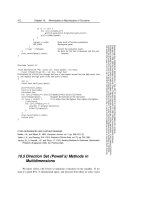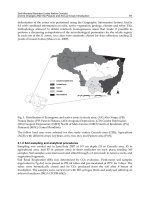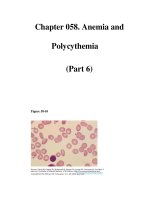Chapter 074. Biology of Obesity (Part 6) ppt
Bạn đang xem bản rút gọn của tài liệu. Xem và tải ngay bản đầy đủ của tài liệu tại đây (47.46 KB, 5 trang )
Chapter 074. Biology of Obesity
(Part 6)
OTHER SPECIFIC SYNDROMES ASSOCIATED WITH OBESITY
Cushing's Syndrome
Although obese patients commonly have central obesity, hypertension, and
glucose intolerance, they lack other specific stigmata of Cushing's syndrome
(Chap. 336). Nonetheless, a potential diagnosis of Cushing's syndrome is often
entertained. Cortisol production and urinary metabolites (17OH steroids) may be
increased in simple obesity. Unlike in Cushing's syndrome, however, cortisol
levels in blood and urine in the basal state and in response to corticotropin-
releasing hormone (CRH) or ACTH are normal; the overnight 1-mg
dexamethasone suppression test is normal in 90%, with the remainder being
normal on a standard 2-day low-dose dexamethasone suppression test. Obesity
may be associated with excessive local reactivation of cortisol in fat by 11β-
hydroxysteroid dehydrogenase 1, an enzyme that converts inactive cortisone to
cortisol.
Hypothyroidism
The possibility of hypothyroidism should be considered, but it is an
uncommon cause of obesity; hypothyroidism is easily ruled out by measuring
thyroid-stimulating hormone (TSH). Much of the weight gain that occurs in
hypothyroidism is due to myxedema (Chap. 335).
Insulinoma
Patients with insulinoma often gain weight as a result of overeating to
avoid hypoglycemic symptoms (Chap. 339). The increased substrate plus high
insulin levels promote energy storage in fat. This can be marked in some
individuals but is modest in most.
Craniopharyngioma and Other Disorders Involving the Hypothalamus
Whether through tumors, trauma, or inflammation, hypothalamic
dysfunction of systems controlling satiety, hunger, and energy expenditure can
cause varying degrees of obesity (Chap. 333). It is uncommon to identify a
discrete anatomic basis for these disorders. Subtle hypothalamic dysfunction is
probably a more common cause of obesity than can be documented using
currently available imaging techniques. Growth hormone (GH), which exerts
lipolytic activity, is diminished in obesity and is increased with weight loss.
Despite low GH levels, insulin-like growth factor (IGF) I (somatomedin)
production is normal, suggesting that GH suppression is a compensatory response
to increased nutritional supply.
PATHOGENESIS OF COMMON OBESITY
Obesity can result from increased energy intake, decreased energy
expenditure, or a combination of the two. Thus, identifying the etiology of obesity
should involve measurements of both parameters. However, it is nearly impossible
to perform direct and accurate measurements of energy intake in free-living
individuals, and the obese, in particular, often underreport intake. Measurements
of chronic energy expenditure have only recently become available using doubly
labeled water or metabolic chamber/rooms. In subjects at stable weight and body
composition, energy intake equals expenditure. Consequently, these techniques
allow assessment of energy intake in free-living individuals. The level of energy
expenditure differs in established obesity, during periods of weight gain or loss,
and in the pre- or postobese state. Studies that fail to take note of this phenomenon
are not easily interpreted.
There is continued interest in the concept of a body weight "set point." This
idea is supported by physiologic mechanisms centered around a sensing system in
adipose tissue that reflects fat stores and a receptor, or "adipostat," that is in the
hypothalamic centers. When fat stores are depleted, the adipostat signal is low,
and the hypothalamus responds by stimulating hunger and decreasing energy
expenditure to conserve energy. Conversely, when fat stores are abundant, the
signal is increased, and the hypothalamus responds by decreasing hunger and
increasing energy expenditure. The recent discovery of the ob gene, and its
product leptin, and the db gene, whose product is the leptin receptor, provides
important elements of a molecular basis for this physiologic concept (see above).
WHAT IS THE STATUS OF FOOD INTAKE IN OBESITY? (DO
THE OBESE EAT MORE THAN THE LEAN?)
This question has stimulated much debate, due in part to the methodologic
difficulties inherent in determining food intake. Many obese individuals believe
that they eat small quantities of food, and this claim has often been supported by
the results of food intake questionnaires. However, it is now established that
average energy expenditure increases as individuals get more obese, due primarily
to the fact that metabolically active lean tissue mass increases with obesity. Given
the laws of thermodynamics, the obese person must therefore eat more than the
average lean person to maintain their increased weight. It may be the case,
however, that a subset of individuals who are predisposed to obesity have the
capacity to become obese initially without an absolute increase in caloric
consumption.









